La settimana scorsa, uno dei nostri lettori ci ha contattato per sapere se la sua sitemap XML restituiva un errore 404 in Yoast SEO. Ci ha ricordato i primi tempi di WordPress, quando abbiamo riscontrato lo stesso problema e non siamo riusciti a trovare una soluzione semplice online.
Da allora, abbiamo aiutato migliaia di utenti di WordPress attraverso WPBeginner, e l’errore della sitemap di Yoast rimane uno dei problemi SEO più comuni che vediamo. Anche se all’inizio può sembrare tecnico, la correzione di questo errore è in realtà più semplice di quanto si possa pensare.
Condivideremo la nostra soluzione testata che ha funzionato per innumerevoli siti WordPress, compreso il nostro. Che siate principianti o utenti esperti, sarete in grado di correggere questo errore e di far funzionare correttamente la vostra sitemap in pochissimo tempo.
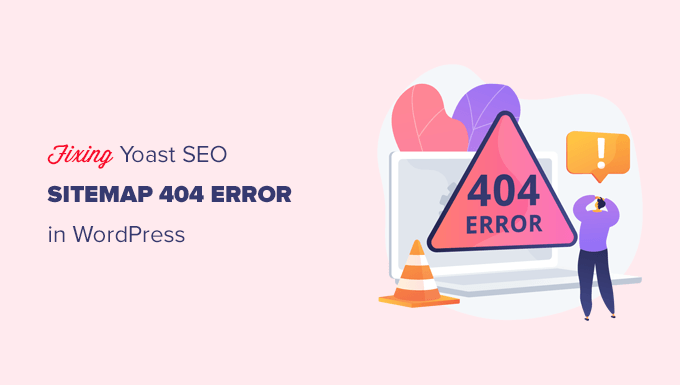
Cosa causa l’errore 404 di Yoast SEO Sitemap in WordPress?
La sitemap di Yoast SEO aiuta i motori di ricerca a trovare tutti i contenuti del vostro sito web che volete che trovino e indicizzino.
La correzione dell’errore garantisce che i motori di ricerca possano accedere alla sitemap e scoprire tutte le pagine e i contenuti del sito. Questo può portare a una migliore visibilità e posizionamento sui motori di ricerca e aiuterà anche a classificare i contenuti più velocemente rispetto a quanto avviene senza una sitemap.
WordPress ha una sitemap XML predefinita che si può inviare a Google Search Console e ad altri motori di ricerca.
La sitemap XML può essere visitata inserendo il seguente URL nella barra degli indirizzi del browser:
https://example.com/sitemap.xml
Tuttavia, la sitemap predefinita generata da WordPress è molto semplice. Per correggere questo problema, tutti i plugin SEO di WordPress in alto, come Yoast SEO e All in One SEO, creano le proprie sitemap XML con più caratteristiche.
Quando si utilizza la sitemap XML generata dal plugin WordPress SEO, il plugin riscrive lo scorciatoia predefinita di WordPress XML sitemap.
Ciò significa che l’URL della sitemap di cui sopra invierà gli utenti alle sitemap generate dal plugin SEO di WordPress.
Purtroppo, questo può causare un errore 404 su alcuni siti web a causa di conflitti tra plugin o impostazioni errate di WordPress.
Nelle sezioni seguenti, vi mostreremo come correggere facilmente l’errore 404 della sitemap di WordPress nel plugin Yoast SEO. Ecco una rapida panoramica di tutti i metodi che metteremo in copertina:
Pronti? Entriamo subito nel vivo.
1. Ricarica della struttura dei Permalink di WordPress
WordPress è dotato di una struttura di URL orientata alla SEO, chiamata permalink. Questa struttura di URL utilizza un sistema di reindirizzamento per indicare al server di hosting web quale pagina caricare quando un utente inserisce un URL nel proprio browser.
Di norma, le impostazioni dei permalink vengono aggiornate automaticamente quando si apportano modifiche al sito web.
La cattiva notizia è che a volte WordPress non è in grado di aggiornare la struttura dei permalink, il che può causare la comparsa dell’errore 404 della sitemap di Yoast SEO.
Detto questo, il problema può essere facilmente corretto andando alla pagina Impostazioni ” Permalinks dall’area di amministrazione di WordPress e facendo clic sul pulsante “Salva modifiche”.
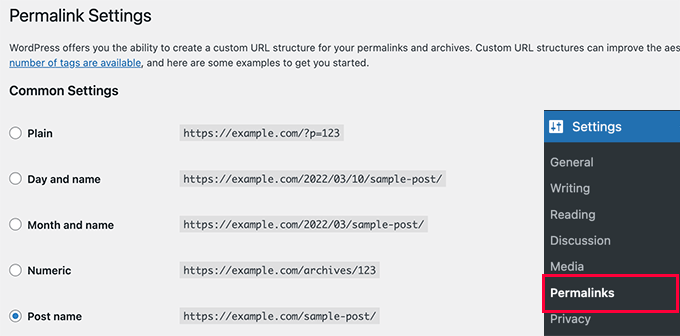
In questo modo si ricaricano le impostazioni dei permalink di WordPress. Ora è possibile visitare la pagina della sitemap XML per verificare se il problema è stato corretto.
Se il problema non è stato corretto, potete continuare a leggere.
2. Aggiornamento manuale dei permalink
Se la ricarica della struttura dei permalink di WordPress non corregge l’errore 404, è possibile indicare manualmente al server web di reindirizzare gli utenti alla pagina della sitemap di Yoast SEO.
A tal fine, è necessario aggiungere il seguente codice al file .htaccess.
1 2 3 4 5 6 7 8 9 | # Yoast SEO - XML Sitemap Rewrite FixRewriteEngine OnRewriteBase /RewriteRule ^sitemap_index.xml$ /index.php?sitemap=1 [L]RewriteRule ^locations.kml$ /index.php?sitemap=wpseo_local_kml [L]RewriteRule ^geo_sitemap.xml$ /index.php?sitemap=geo [L]RewriteRule ^([^/]+?)-sitemap([0-9]+)?.xml$ /index.php?sitemap=$1&sitemap_n=$2 [L]RewriteRule ^([a-z]+)?-?sitemap.xsl$ /index.php?yoast-sitemap-xsl=$1 [L]# END Yoast SEO - XML Sitemap Rewrite Fix |
Nota: se il vostro sito web WordPress è installato in una sottodirectory o cartella (ad esempio https://example.com/mywebsite/ ), dovrete utilizzare il seguente codice.
1 2 3 4 5 6 7 8 9 | # Yoast SEO - XML Sitemap Rewrite FixRewriteEngine OnRewriteBase /mywebsite/RewriteRule ^sitemap_index.xml$ /index.php?sitemap=1 [L]RewriteRule ^locations.kml$ /index.php?sitemap=wpseo_local_kml [L]RewriteRule ^geo_sitemap.xml$ /index.php?sitemap=geo [L]RewriteRule ^([^/]+?)-sitemap([0-9]+)?.xml$ /index.php?sitemap=$1&sitemap_n=$2 [L]RewriteRule ^([a-z]+)?-?sitemap.xsl$ /index.php?yoast-sitemap-xsl=$1 [L]# END Yoast SEO - XML Sitemap Rewrite Fix |
Non dimenticate di sostituire /mywebsite/ con il nome della vostra sottodirectory.
Questo codice indica semplicemente al vostro server quali pagine visualizzare quando gli utenti accedono alle sitemap XML di Yoast SEO.
Ora si può provare a visualizzare la sitemap XML per vedere se il problema si corregge.
3. Passare a un plugin XML Sitemaps
Se i metodi sopra descritti non hanno risolto l’errore 404 sulla pagina della sitemap XML di Yoast SEO, si può provare a utilizzare un plugin separato per generare sitemap XML per il sito web. Un buon plugin è il plugin XML Sitemaps.
Lo svantaggio di questo approccio è che dovrete affidarvi a un plugin separato per generare sitemap XML e a Yoast SEO per altre caratteristiche SEO.
Per prima cosa, è necessario installare e attivare il plugin XML Sitemaps. Per maggiori dettagli, potete consultare la nostra guida passo-passo su come installare un plugin di WordPress.
Poiché si utilizza Yoast SEO, si riceverà automaticamente una notifica per disabilitare il plugin XML Sitemaps o la funzionalità sitemap di Yoast SEO.
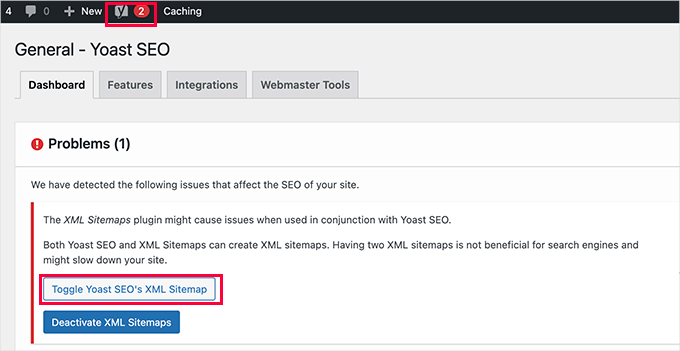
Quindi, si può fare clic sul pulsante “Attiva/disattiva la Sitemap XML di Yoast SEO” per continuare.
Si accede così alla scheda “Caratteristiche” sotto la voce SEO ” Generale”. Da qui, dovrete scorrere giù fino all’opzione “XML sitemaps” e disattivarla.
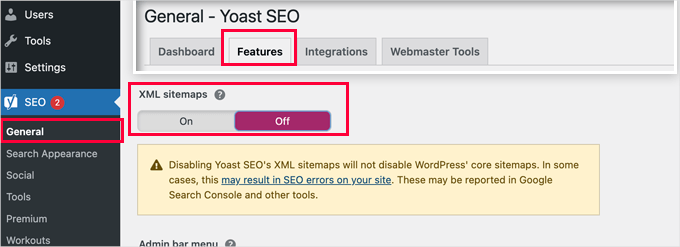
Non dimenticate di fare clic sul pulsante “Salva modifiche” per salvare le impostazioni.
Ora è possibile passare alla pagina Impostazioni ” XML-Sitemap per configurare le sitemap. Per la maggior parte dei siti web, le impostazioni predefinite funzionano subito.
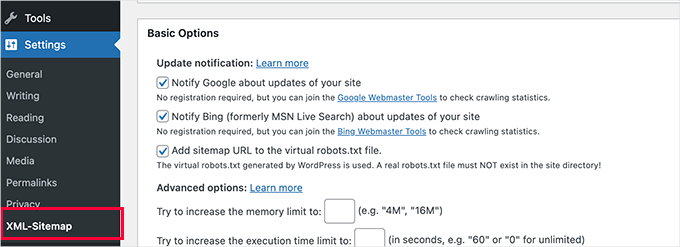
Ma è sempre possibile configurare le impostazioni in base alle proprie esigenze.
Ora è possibile inviare l’URL della sitemap XML alla Search Console di Google e ad altri motori di ricerca.
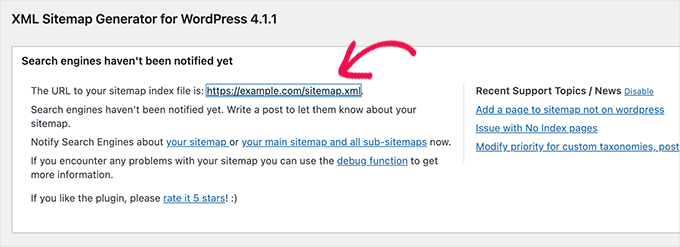
4. Passare a Tutto-in-uno SEO per WordPress
Se tutto-in-uno non funziona e non si vuole usare un plugin separato per generare sitemap XML, questo metodo può aiutare a correggere l’errore 404 della sitemap.
Per questo metodo, è necessario All in One SEO per WordPress. È il miglior plugin SEO per WordPress presente sul mercato e un’alternativa molto migliore a Yoast SEO.
Per maggiori dettagli sulle differenze, potete consultare il nostro confronto Yoast vs All in One SEO.
Tutto-in-uno SEO (AIOSEO) è dotato di sitemap XML avanzate e di opzioni facili da gestire che consentono all’utente di avere il pieno controllo su cosa includere o escludere da esse.
Per prima cosa, installiamo e attiviamo il plugin All in One SEO for WordPress. Per maggiori dettagli, consultate la nostra guida passo-passo su come installare un plugin per WordPress.
Nota: esiste anche una versione gratuita di All in One SEO per WordPress, che include la maggior parte delle caratteristiche delle sitemap XML, ad eccezione di video e notizie.
Dopo l’attivazione, il plugin vi guiderà attraverso una configurazione guidata. Se avete bisogno di aiuto durante la configurazione, seguite la nostra guida su come impostare correttamente il plugin All in One SEO per WordPress.
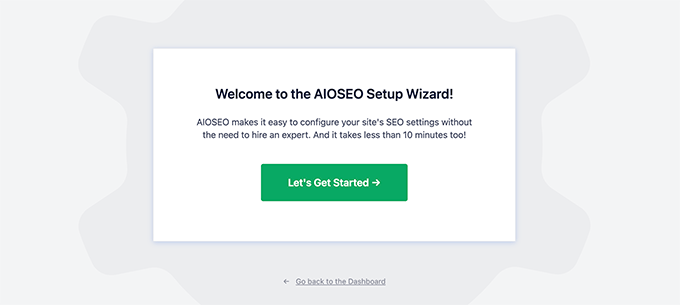
All in One SEO vi permetterà anche di importare i dati SEO da Yoast SEO.
Questo assicura che tutti i meta tag e i titoli SEO precedenti rimangano invariati.
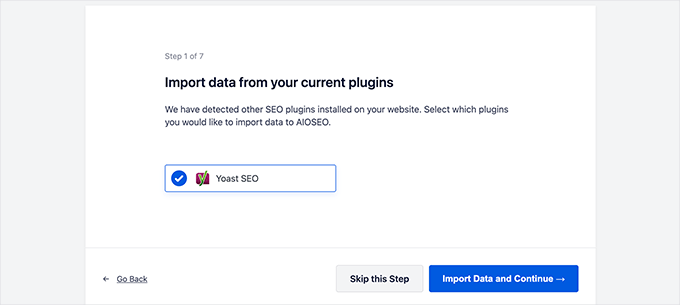
Dopo la configurazione iniziale, si può andare alla pagina All in One SEO ” Sitemaps per configurare le impostazioni della sitemap XML.
È possibile fare clic sul pulsante “Apri Sitemap” per verificare se è stato corretto l’errore 404 della sitemap di WordPress.
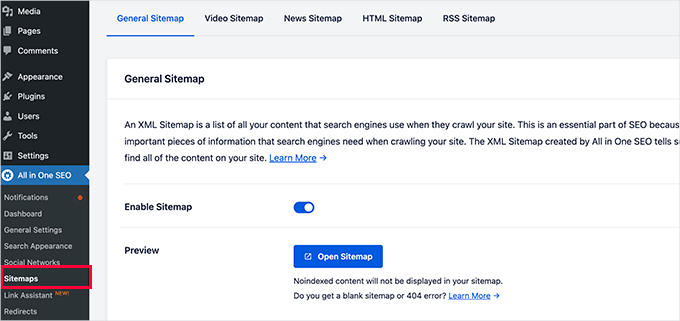
Successivamente, si configurano le impostazioni della sitemap, se necessario.
Per esempio, All in One SEO consente di scegliere cosa includere nelle sitemap. È possibile aggiungere o rimuovere post type, tassonomie, singoli articoli e pagine.
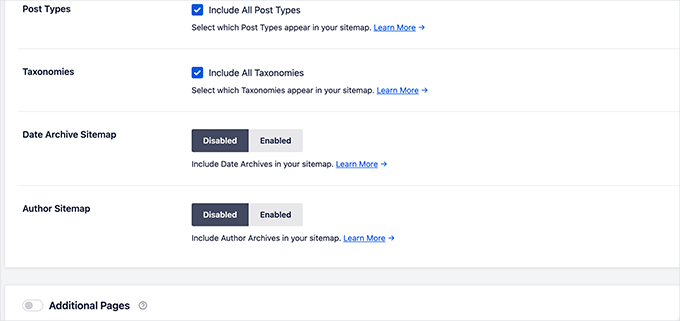
All in One SEO permette anche di creare video, notizie, sitemap RSS e sitemap HTML per il vostro sito web.
È sufficiente esplorare le schede per verificare se si desidera configurare altre impostazioni.
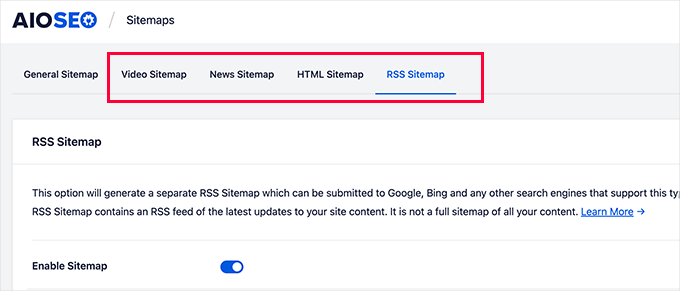
Queste sitemap possono anche essere inviate a Google Search Console e ad altri motori di ricerca. Questo aiuta i motori di ricerca a trovare rapidamente i nuovi contenuti del sito web.
Suggerimento dell’esperto: Non volete correggere da soli un errore di WordPress? Niente paura: siamo noi ad avervi messo alla copertina! Dite addio a errori frustranti e tornate a concentrarvi su ciò che amate. Lasciate che siamo noi a occuparci delle questioni tecniche e prenotate subito il nostro servizio di assistenza WordPress di emergenza!
Speriamo che questo articolo vi abbia aiutato a correggere l’errore 404 di Yoast SEO Sitemap su WordPress. Potreste anche consultare la nostra guida su come disabilitare facilmente la sitemap predefinita di WordPress o la nostra scelta dei migliori strumenti di ottimizzazione dei contenuti online per WordPress.
Se questo articolo vi è piaciuto, iscrivetevi al nostro canale YouTube per le esercitazioni video su WordPress. Potete trovarci anche su Twitter e Facebook.





CB
Hi, just tried the second version editing the plug ins core files and the site has disapeared?? including the backend. just a white screen?? I replaced the code withy the original and nothing.
Matt Crystal
Thank you! That worked by supplying the code in the .htaccess file, then unchecking the site map option and saving. Then, re-checking the box and saving again. Thanks!
Roderick van Straten
Added this code to the .htaccess and unchecked and checked it, but I only get a blank page now for the sitemap ..
mandingo345
yes, without fix, just uncheck save recheck and saved.
Tidus Ha
the last update work perfect for me. thank you.
Jack
After loosing quite some time trying to find what was wrong, I got it working by your suggestion “Uncheck the sitemap option in the Yoast’s SEO plugin and ‘save’ settings. After that re-checking the sitemap’s option fixes the error.”
tnx very much!
johnny
Thank you so much! unchecking, saving, rechecking saving did the trick!
sc456a
After I added the code to htaccess and unchecked/rechecked Sitemap in the plugin, it worked! Thanks!
Taylor
Worked!! Thank you!
alireza
it work for me too, Thanks a lot!
Leo
Uncheck then save, then go back check again and save, solved my problem. It should be at the begining before anybody try anything else! it worked for me thanks though
Elle Laurel Rose
Woohoo! Thanks. Mine probably wasn’t broken long because Google didn’t seem to mind yet. … But my site is only in a softer launch stage anyway… Slow crawls maybe. Luckily, I’m improving my site before my real projects go up (hopefully soon).
Anyway I cannot thank you enough.
logitaki
I opened the class-sitemaps.php file but can’t find the section you are referring to “functiion () init code.. can you be more specific?
Basie
Editing the .htaccess file, un-checking sitemap generation, saving settings, re-checking, saving settings … fixed it for me! Thank you VERY much.
Tom Atkinson
I found my issue was actually fixed purely by turning Yoasts sitemaps on and off from UI. Which is great!
Fernando
Were you able to fix this one? I’m having the same problem, I get a 404 on post-sitemap.xml. I didn’t check the PHP logs on what the error is but probably would be the same you’re getting.
Steve
No fix, and theres no replies to support threads on wordpress, other people are just disabling it and using another sitemap plugin.
Baidya nath Singh
It worked with the first code to .htaccess. Thanks.
hayderabbass
Disabling the XML sitemap and re enabling them fix this issue for me. Thanks!
Ben Billson
I was having an issue with the sitemap 404’ing when trying to access it.
I tried adding the first ifmodule, no joy, then remembered I had another ifmodule in place to handle redirects after updating my permalink structure.
I removed the redirect ifmodule, restarted Worpress SEO, then the sitemaps started working. Re-added the redirect ifmodule, and everything now appears to be working just fine. I’ve also checked the status in GWT and Bing WT and it’s all looking good. Thanks for the help!
Rob Cooper
I put the first Ifmodule into htaccess and it spit out some weird single line of content, with no links.
I read through the comments
then I rebooted Yoast’s sitemap option:
i unchecked the “Enable XML Sitemap Here” and saved
I re-checked it and saved
checked my sitemap and it was there, formatted properly with xsl stylesheet being applied and links all worked
chiappa
I have no idea where to put that code. There is no line like: “function init()” in class-sitemaps.php
Katrina Isabelle
Try going into your permalink settings and saving them again. If you can’t access the back end of your site because of the 500 error, then remove that htaccess file.
Katrina Isabelle
Hello! I think you should add one more step at the very beginning: Re-save your permalink settings! I found that re-saving my permalink settings solved the issue for me. No need to go into the htaccess file.
EB
Exactly, solved my problem too.
Alfonso
this fixed the issue for me, re-saving the WP permalinks
Steve
I get the following error only on post-sitemap, all other sitemaps work ok:
Fatal error: Allowed memory size../plugins/wordpress-seo/inc/class-sitemaps.php on line 713
I tried the htaccess and wpseo-functions edits but no luck.
I deactivated every plugin, still no luck.
I deleted wpseo and reinstalled but still same problem and now on the wpseo dashboard and sitemaps page I get this error:
Warning: call_user_func_array() expects parameter 1 to be a valid callback, function ‘wpseo_xml_sitemaps_init’ not found or invalid function name in /home/justplay/public_html/wp/wp-includes/plugin.php on line 470
I have two sites running the same theme, plugins etc and one works ok one has this errors, wierd.
Jane Hockley
Thank you – i found just by unchecking and saving and then re-checking the site map option for the yoast plugin google webmaster was able to find my site map
eliascan
Worked for me too. Thanks
Jared Eitnier
Worked for me as well, good call.
Michael Erickson
Thanks Jane!
Taylor
Thank you!! Worked like a charm
Jesse
This worked for me too. Thanks!
Brent Norris
yep got rid of the 3 errors displayed in webmaster tools. thanks
Saw Panse
Worked like a charm. Thanks @janehockley:disqus
Abhishek Mishra
Guys really you are amazing, yeah AMAZING.. this blog is really helpful for me
Jake Ratliff
When I tried the htaccess method, it crashed my site. I just added this code into the htaccess file (via the Yoast plugin):
# WordPress SEO – XML Sitemap Rewrite Fix
RewriteEngine On
RewriteBase /
RewriteRule ^sitemap_index.xml$ /index.php?sitemap=1 [L]
RewriteRule ^([^/]+?)-sitemap([0-9]+)?.xml$ /index.php?sitemap=$1&sitemap_n=$2 [L]
# END WordPress SEO – XML Sitemap Rewrite Fix
And then clicked the “save changes to .htaccess” button. I can’t go anywhere without the 500 error now. What did I do wrong? Anyone know how to fix this?
Jake Ratliff
I tried the htaccess fix and now I get a 500 Internal Server Error.
Mark Haller
@NicolasJoly:disqus you star, well done, thanks so much!
Tiffany Marie McAnally
So it still doesn’t work for me… I feel like beating my head against a wall. As much as I love the plugin, I think I’m just going to lose it in favor of something that’s actually functional.
Jérôme Lafforgue
Thanks, work fine in wpseo-functions.php file @ line 461
ast
for me worked fine!
thank you
NicolasJoly
@Matt Klein, it’s in the wpseo-functions.php file @ line 461
NicolasJoly
@Matt Klein, the ‘init’ function is now ‘wpseo_xml_sitemaps_init’ in the wpseo-functions.php, @line 461
Add just :
global $wp_rewrite; before the $GLOBALS define
and
$wp_rewrite->flush_rules(); after the add_rewrite_rule…
/**
* Initialize sitemaps. Add sitemap & XSL rewrite rules and query vars
*/
function wpseo_xml_sitemaps_init() {
$options = get_option( ‘wpseo_xml’ );
if ( $options[‘enablexmlsitemap’] !== true ) {
return;
}
// redirects sitemap.xml to sitemap_index.xml
add_action( ‘template_redirect’, ‘wpseo_xml_redirect_sitemap’, 0 );
if ( ! is_object( $GLOBALS[‘wp’] ) ) {
return;
}
global $wp_rewrite;
$GLOBALS[‘wp’]->add_query_var( ‘sitemap’ );
$GLOBALS[‘wp’]->add_query_var( ‘sitemap_n’ );
$GLOBALS[‘wp’]->add_query_var( ‘xsl’ );
add_rewrite_rule( ‘sitemap_index.xml$’, ‘index.php?sitemap=1’, ‘top’ );
add_rewrite_rule( ‘([^/]+?)-sitemap([0-9]+)?.xml$’, ‘index.php?sitemap=$matches[1]&sitemap_n=$matches[2]’, ‘top’ );
add_rewrite_rule( ‘([a-z]+)?-?sitemap.xsl$’, ‘index.php?xsl=$matches[1]’, ‘top’ );
$wp_rewrite->flush_rules();
}
Matt Klein
There is no function init area in my class-sitemaps.php file. Could it be called something else. What line is it on?
Regina Falkowski
Added the code to .htaccess file and it worked like a charm! Thanks for the fix
Alec Byrne
Adding the .htaccess worked for me – thanks very much
Desainwebs
Still not work for me
Ollie
Htaccess fix worked for me.
But as Scott in the first comment above says, I needed to uncheck the XML sitemap checkbox and save. Then recheck it and save again for the sitemap to show up. I think that would be worth mentioning in the article.
WPBeginner Support
Ollie, yes we have updated the article.
Admin
Steve Patterson
Thanks this worked for me editing the .htaccess file. I unchecked sitemaps off then back on and also changed mine from 1,000 to 400. If you are on a shared server, I would use a lower number so that less CPU usage is done on your domain.
scott
Hi guys,
I had to troubleshoot this issue too. My site is hosted in a sub directory of a main site. So I had to set the following line:
RewriteBase /scottmortiz/
I then had to uncheck the mina Site Map XML option in the plugin, and save. Then re-check the plugin and save. Hope this works for some of you.
-Scott
Chris
Hi Steven,
thank alot. This helped me, too. But to get the rewrite working I had to disable the xml function, save it, and enable (and save it) again. Seems obvious, but maybe this is worth a note in the article. I will safe this article in my personal wordpress help register.
Thanks,
Chris
Dan
Thank you Chris! This fixed my 404 problem with Yoast’s XML Sitemap feature.
Jason Judge
Ah, switch it off, then switch it back on again. Thanks:-) It is not as obvious as you think. My sitemaps also did not work (getting a 404) until I did this. I did not have to make any of the other changes described in this post.
Shanthi Ganesan
@PEKKO Hi Tried your techniques it really works well,thanks a lot for sharing….
Lukas
Nothing is working in my case – still Error 404 …
Ryan
Beauty, fixed it for me too.. thanks for putting this up
lloyd
this just broke my websites … now getting an internal server error…
Rosie
The edit to .htaccess files was just the trick. Thanks for posting this! You saved me a whole lot of time and trouble.
Pekko
I was just facing the same issue. i unticked the box (Check this box to enable XML sitemap functionality) — pressed save, and then ticked the box again, after that It found the sitemap again, Hope it will be there!
Anisa
I use this technique, and it worked
John
This worked for me, as well. Thx!
Cara Sherlock
Unchecking, saving and then rechecking worked for me too. Thx!
Badprimer
[..unticked the box (Check this box to enable XML sitemap functionality) — pressed save, and then ticked the box again..]
Worked for me. Thx!!
Kerry
Thank you! Worked for me too! So simple. The author of this article should add this too.
bruce
This also worked for me. turn off sitemaps. save. turn them back on. save. fixed
David
Same for me, unchecked, saved, checked, saved, voila!
hobbsy
this worked for me too
Hugo
Hi,
I’m still having some troubles with my website:
My site map contains a lot of files like this one:
http://www.blenheimgang.com/wp-content/uploads/media/2013/09/BCRR-E30-25.jpg
and they refer to a broken link. How can I delete them?
WPBeginner Support
Doesn’t look like a broken link.
Admin
Steven
I’ll just share what worked for me, by changing the ‘max entries per site map’ to 250 (ie. something less than 1000) I managed to fix the 404 error. I think the server was having issues processing 1000 entries which is the default.
Maggie
Hi Steven, this is great solution! I just fixed the problem by your method. Thank you very much!
PromInc
Thanks Steven – this resolved my issue as well. The ‘max entries…’ field was blank for me; simply adding any value seemed to work, which is good as I felt 250 was a bit low. Very simple but effective solution.
Nick Root
That worked thanks for the tip!